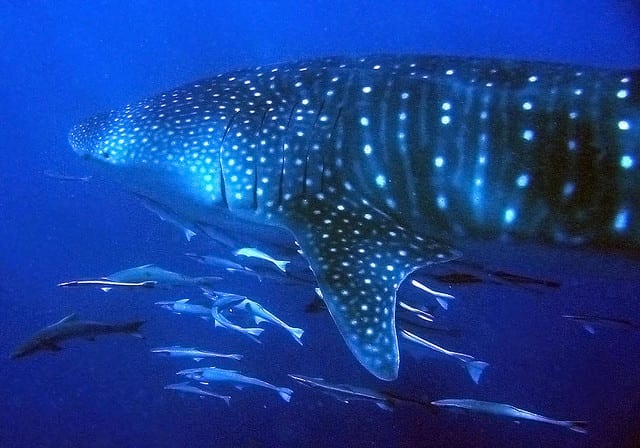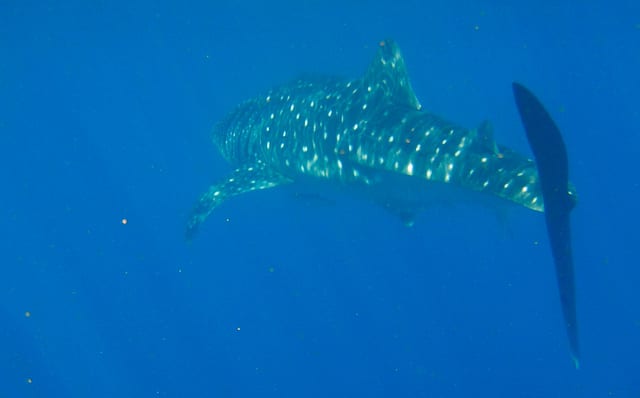
“Oh wow! You can swim with Whale Sharks in Western Australia,” I exclaimed as I flipped through my guidebook, tentatively planning out my three month long Australian overland adventure.
“Wait…what is a whale shark? Doesn’t matter… sounds awesome…and we will be there for Whale Shark season as well!”
A quick internet search proved that being in the right place at the right time during Whale Shark season was indeed something to say “oh wow!” to.
What is a Whale Shark?
Whale sharks aren’t really whales (they are fish), and they aren’t really sharks (they eat plankton). Ok, well according to Wikipedia they are actually a shark – but not in the Jaws sort of “OMG he ate my leg” sort of way that we normally think of sharks. Whale sharks are filter feeders, meaning they feed on plankton. And like whales who also feed on plankton, whale sharks get pretty darned big – they are the biggest fish in the ocean actually.
They can grow up to 12 meters long, weigh up to 21 metric tons, and rival some of the dinosaurs in size and weight.
Wait a minute? Is it safe? Doesn’t everything in Australia want to kill people?
Whale sharks are one of the few animals in Australia that doesn’t want to kill you! In fact, it really couldn’t care much about you. They are extremely gentle, and don’t seem to mind a bunch of puny little weak humans swimming around them either. The only way you can be injured while swimming with a whale shark is if you get in the way of its massive and powerful tail. Or if you almost vomit yourself to death like I did on the boat ride out to see them, like I did – but that’s another story.

So where do I have to go to swim with a whale shark?
There are a few places in the world where you can go to swim with whale sharks. The main three being Mexico, Philippines, and Australia. I would argue that Australia is the best place to go and see them though. Like everything else in Australia, it will likely be much more expensive than the other two places, but in Australia there are two advantages. 1) Part of your fee goes towards whale shark conservation and 2) Australia is the only place which sends out spotter planes to find the whale sharks in advance – making it much more likely you will actually get to have your swim.
The place to be in Australia is called Ningaloo Reef. You can access the reef from two small towns: Coral Bay, and Exmouth. Both of these places are pretty far away from anything else in Australia. Located about a 12.5 hour drive north from Perth in Western Australia, this is the place to see whale sharks. The whale shark migration passes through Ningaloo from April through to July.
What can I expect on my whale shark swim?
Tours depart daily, and they depart very early in the morning. You will be provided with a wetsuit and snorkelling gear and head out to your boat. As we boarded our boat we saw a family of dolphins playing near the beach.
Our first stop was at the reef which surrounds the coast. Here we went for our first snorkel around the colourful coral reef where we saw all sorts of brightly marked fish and even some sea turtles. The fish were not afraid of us at all, and even though I know I am much bigger than them, it really freaked me out when they came up and touched my mask.
We continued snorkelling and eating snacks until the spotter plane radioed in with the location of a whale shark. The whale sharks feed outside of the outer reef, and without the help of the planes it would be very difficult to actually find them. On several occasions, when we got to the whale shark location it was actually no where to be found, as it has decided to dive deep into the depths of the ocean.
When we did locate a shark it was time to jump in. We were instructed on the safe place to swim, and soon set off, forming two lines which swum on each side of the whale shark. The whale shark took no notice of us, and just calmly swam along, taking in giant mouth fulls of water to filter out some lunch. Eventually when he grew tired of us, he dove down into the sea and disappeared from sight.
Exhilarated we got back on the boat and started to head off to the next set of coordinates where a whale shark had been spotted. By the end of the day we had swum with three whale sharks, a manta ray, a reef shark, some turtles, and a whole lot of coral reef fish. Not a bad day out on the water eh?

Tips for making the most our of your whale shark experience (mostly based on the mistakes that we made!)
- Tours depart early, get an early night if possible. (aka try not to get too drunk the night before)
- Tours are dependant on the weather and can be cancelled at short notice. This happened to us and luckily we were able to rearrange our travel plans in order to stay an extra few days. Make sure your itinerary is flexible enough to accommodate this.
- The waters beyond the outer reef are very rough! If you get sea sick like I do, then prepare yourself! Otherwise you may spend the entire day vomiting into the ocean like I did.
- Listen to the staff on board to ensure that both you and the wildlife you are swimming with stay safe.
- If you have a waterproof camera… take it! This is a once in a lifetime experience.
How much will it cost me?
Tours average between $375 and $460 for a day trip, depending on which company you choose. Ask them about special offers though, we were able to use our VIP backpackers discount cards and get $75 off each on our particular tour.
Where can I find out more about whale shark tour operators?
The Exmouth tourism website has a good list of tour companies in both Exmouth and in Coral Bay. We took our tour from Coral Bay because it was easier to get to via public transport, but Exmouth has more options available.
This article was originally published on Art of Adventuring, then moved to WW in February 2017.
